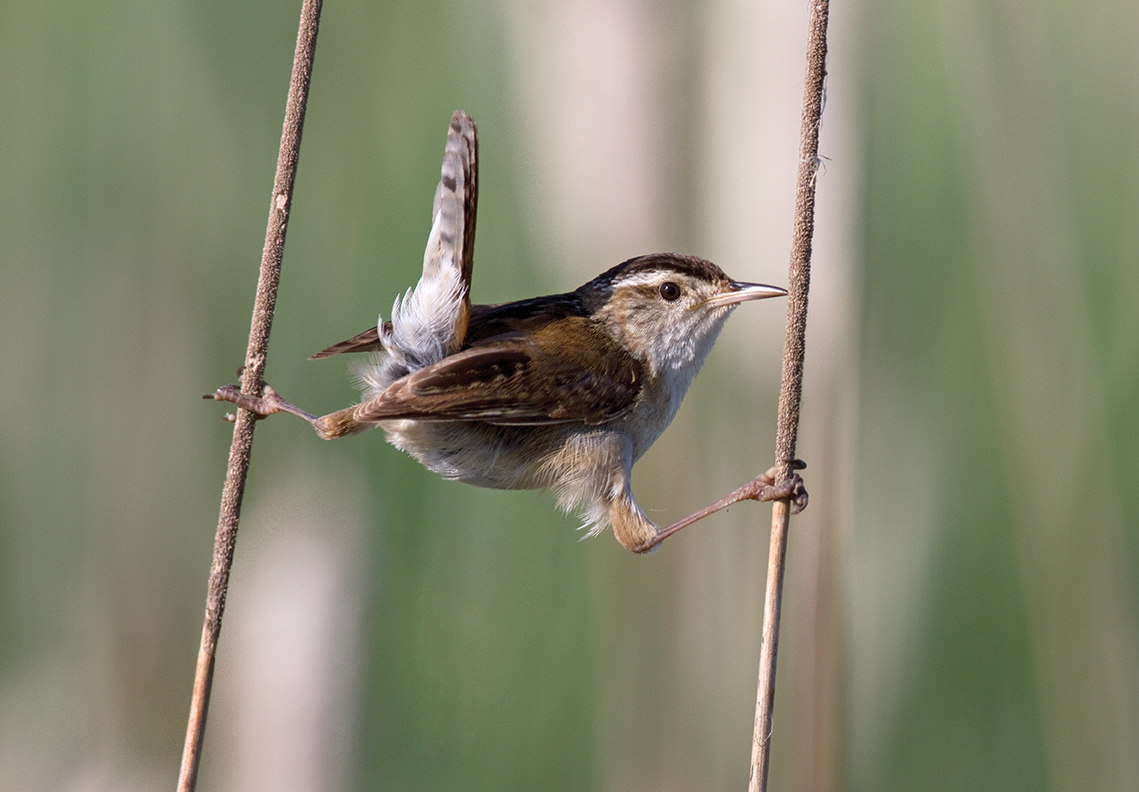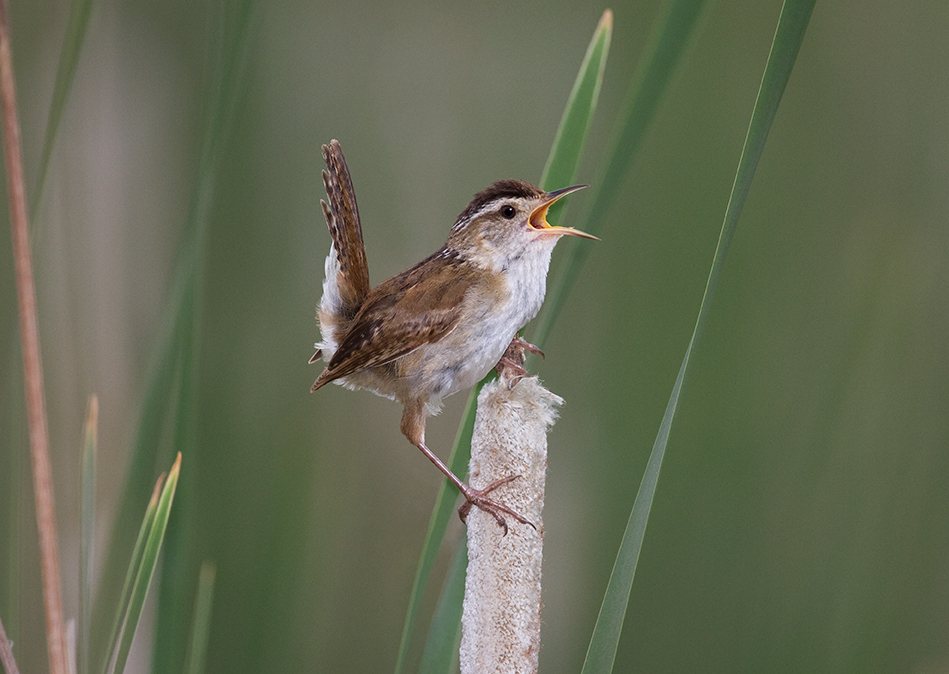
Marsh Wren, Singing; Stutsman County, North Dakota, June 2013. © William Burt
The Marsh Wren
Story and Photos by William Burt
How to photograph this flirt-tailed gremlin of the reeds? The problem had bedeviled me for years—for decades, really—and we’ll get to that; but first I have a few reflections on this feisty little bird, so fondly known to anyone acquainted with the marshes. If you’ve paddled through or past the cattails with a watchful eye, chances are you’ve glimpsed it peering through the stalks and chiding with a harsh chak-ak. And then its song: you’ve surely heard its “gurgling” song. Its “reedy gurgling”—that’s how Roger Tory Peterson portrayed it, with his usual genius for the word that tells.
I first got to know that “gurgling” at the mouth of the Connecticut, where I spent summers as a boy. It was a constant presence, drifting in at all hours of the day from the vast cattail meadows out beyond grandfather’s dock; and if I was so lucky as to room out on the sleeping porch, I’d sometimes wake to hear some lone male serenading through the night—but only through the last days of July. By early August, all was drowned out by the grinding din of katydids.
The marsh wren’s is a heartening song, bursting with mirth and yet a little wistful, too, in all its striving. It starts as a mere splutter but then catches, finds its moment, and breaks out into a soaring, bubbly music; and the singer is an inspiration to the eye, as well. The male bird perches high upon a stalk with legs splayed wide and tail above his back, throws back his head and sings, all 12 grams jouncing to the last—as if each jounce might help to get the notes out. He sometimes sings with legs splayed wide between two stalks, like a gymnastic funny man: “doing the splits,” as the expression goes. He even sings en route when darting to or from the nest, and should there be a worm or two stuffed in his maw, no matter; he sings anyhow. But this determined virtuoso does one better still. He sings above the marsh, in flight: like an exultant longspur or lark bunting of the Northern Plains.
He shoots off low above the cattails and sweeps upward 10 or 15 feet then slows, wings buzzing in a fury, tips his head back to the sky, and sings for all he’s worth, then arcs back downward slowly and falls belly-first into the marsh, still singing as he goes. It’s an exhilarating sight. In those last wing-buzzing moments he descends so slowly, almost grudgingly, it seems he’s being pulled in by a string.
To Witmer Stone, the old-time bird man of New Jersey, the wing-buzzing wren suggested “a great bumble bee.”
The marsh wren is “The wren of the cattail marsh,” as Peterson had pegged it in the early versions of his Field Guide, and indeed it’s fair to say that almost any sizable tract of cattail marsh here in the northern states will entertain at least a small community. Yet the bird is often equally at home within lush stands of sedges (Carex spp.), bulrush (Scirpus), wild rice (Zizania), and other tall-stemmed plants of fresh or brackish marshes; and it will even nest in an especially plush expanse of saltmarsh cordgrass (Spartina alterniflora). So all it needs, apparently, is those tall stems and blades (and many of them).
In days gone by, some marshes held this species in fantastic numbers. In 1883 one Ji. B. Haines of New Jersey, himself an egg collector of the day, remarked that “I have known a collector to obtain 400–500 eggs in a day.” So given that the marsh wren’s average egg clutch numbers roughly five, this one man must have cleaned out something like 100 nests—and in one day!
The marsh wren’s egg production is no longer savaged at the hand of man, of course; but its home marshes are: by dumping, draining, development, and introduction of the dread invasive reed, Phragmites (just take a look to either side next time you’re gliding by Elizabeth, New Jersey, on I-95).

Marsh Wren, Straddling; Stutsman County, North Dakota, June 2013. © William Burt
Some years ago, when wading in the fringes of a prairie lake in southwestern Saskatchewan, I was surprised to find my old friends chattering away among the eight-foot shafts of softstem bulrush. Yet more surprising still was their half-hearted songs, which struck me as perfunctory and amateurish, like the efforts of a high school orchestra. They had the sputtered rattling quality but nothing of the music, or the surging cheer of eastern songs—which I’d been hearing just the week before, next door in North Dakota. So why these birds, and why here? Why this lakebound population?
I learned later that the marsh wren had been lately deemed to be of two distinct sub-species, an eastern and a western; and that our easterners range west to “central Saskatchewan.” So those rattling amateurs I’d heard were western marsh wrens, at their very eastern limit.
What else does a male marsh wren do with all that energy? You’d think he had enough to do with all the non-stop singing and the wooing, chasing, and maintaining of a mate (or two, or three: he is polygynous); but no, he’s a prodigious nest builder, as well. And fabricating even one nest of the marsh wren kind could be no easy chore.
Your ordinary backyard house wren builds within existing structures—birdhouses, tree cavities—but not this wren. He starts from scratch, with nothing for support but a few tall, free-swaying stalks and blades, to which he weaves a coconut-shaped ball of vegetation with a hollowed-out interior and a discreet “mouse hole” in the side for coming and going. And just inside the hole, for reasons nobody can say, he adds a neatly crafted sill, or doorstep.
It’s an impressive structure, not only large for a mere wren’s but smartly built and solid, as they say, as a brick “outhouse.” Upon accepting it, the female tidies up the interior with layers of fine grasses, cattail down, and feathers; for this one nest will be the one that counts: the “brood nest,” to which she will entrust her eggs.
This one nest? Yes, that’s right, because for every brood nest the male builds half a dozen ‘dummy nests’ or more—to confound predators, perhaps; or merely to impress his concubines? While convincing at a glance, these dummy nests are usually no more than roughed-out balls of vegetation with dead-ended entrance holes, and thus no hollowed-out interior at all (let alone such niceties as door sills). But he produces constantly, frenetically, one nest upon another; and indeed some fevered males have turned out up to 20 dummies in a season.
Sometimes the marsh wren turns his energy to yet another, darker enterprise; and years ago that enterprise undid me of a hard-earned photo opportunity.
I’d spent weeks in the marshes searching for the nest of a least bittern, on the dear hope that I might set up and photograph the birds. I’d even built an elaborate new deep-water blind, so that when the big day came, I would be ready, and at last one day it happened: in a rank, deep-water bulrush marsh known ominously as Dead Man’s Swamp. It was a beauty of a nest, suspended high above the water and arched over gracefully with long green blades, and there laid out upon their reedy platform were the four pale bluish eggs, arranged impeccably with small ends toward the center, like spokes of a wheel. But they were punctured, every one, by what could only be the sharp beak of a bird; and I knew whose.
I’d read accounts of marsh wrens vandalizing eggs of neighboring least bitterns, red-winged blackbirds, even other marsh wrens—at least two old-time naturalists had actually seen it happen—and to be sure, this Dead Man’s Swamp was full of marsh wrens. Had it been the work of a crazed individual, or is every marsh wren a potential vandal? I don’t know. Nobody knows. But at the time I could have vandalized that marsh wren with a sling shot.
In time, I’d get my bitterns. But how to photograph the wren…and photograph it singing? For all the hours I’d spent in marshes, I had not one photo worthy of the marsh wren.
I did make one heroic effort years ago, when in my eager twenties; though I might have spared myself the bother. I’d found a handsome nest with well-grown young, out on a big marsh in the river called Great Island; so I turned the skiff for home, retrieved a blind and motored out again, set up the blind some distance from the nest and left it, so the parents would become accustomed; and the next day I returned again, to move it closer. Then at last, one steamy morning early in July I motored back out with a boatload of equipment, and set up. And while the marsh wrens came and went to feed their young outside the blind, I sat inside my brown cloth oven for two desiccating hours and dripped, dabbed face and neck relentlessly, and snapped what photographs I could.
And my reward, for all the time and trouble and discomfort? It would arrive by mail in its bright yellow box of 36, as usual; but not one frame would be worth keeping.
That was some 45 years ago. But just a few years back I happened on a more convenient nest and tried again, if rather less “heroically.” I was driving down a soggy North Dakota farm road through a handsome swathe of cattails when I caught sight of a nest only a few feet in, and pulled up to a stop. As if on cue the wren popped up with something green pinched in its bill and sang, then darted for the nest and darted in, shot right back out without the green thing and perched high upon a cattail spire, threw back his head and sang again, triumphant. Aha…this was an opportunity. And if you don’t take opportunities, I knew, you don’t take photographs worth keeping.
If I’d learned anything for those past 40-some years, it’s that.
Okay: the late-day light was warm but soft, suffused by a thin smoky veil of evening cloud. Ideal: soft shadows only. I backed up and jogged my ad hoc “rolling blind” until just so and parked, set up the camera with a big 500mm tele, then reached over for a flash and made connections, set it for a touch of fill, and then…okay. I rolled the window down, reclined the seat and sat back to have some fun, relax, and photograph a marsh wren singing.
And this time the results would be worth keeping.
William Burt is a naturalist, photographer, and writer with a passion for wild places—especially marshes—and the elusive birds few people see. His photographs and stories are seen in Smithsonian, Audubon, National Wildlife, and other magazines, and he is the author of four books: Shadowbirds (1994); Rare & Elusive Birds of North America (2001); Marshes: The Disappearing Edens (2007); and Water Babies (2015). He lectures often, and his traveling exhibitions have shown at some 35 museums across the US and Canada—including the Carnegie Museum of Natural History, the New Brunswick Museum, the Calgary Science Center, the Liberty Science Center, the Natural History Museum of Los Angeles County, and the Harvard Museum of Natural History.

